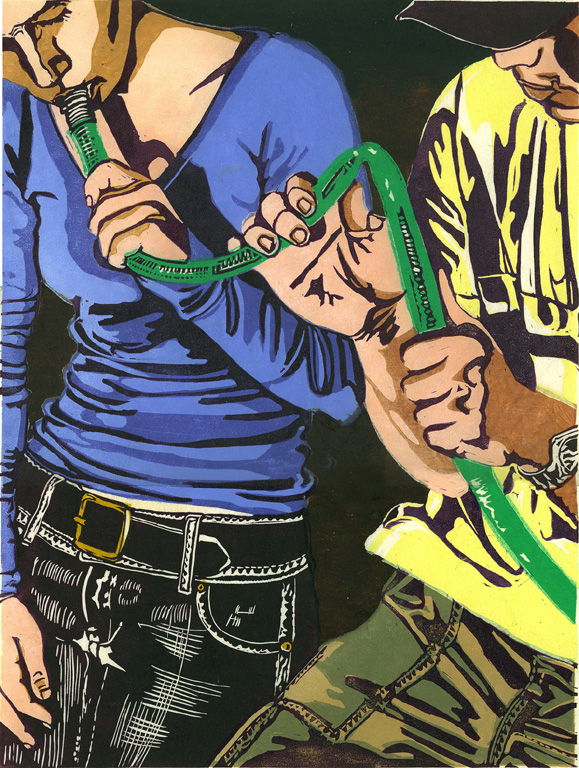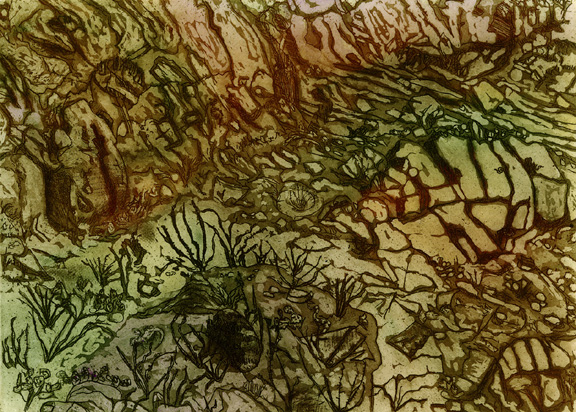Words and Pictures, Pictures and Words
Julia Durst responds to Response: Artists of the Northern Printmakers Alliance & Poets of the Lake Superior Writers At Northern Prints Gallery, Duluth, through November 11. Get the book from Calyx Press here.


Words or pictures– it’s hard to know which to look at first. Poems are paired with prints in “Response,” on exhibit at Northern Prints Gallery (NPG) through November 11. It’s a joint project of the Lake Superior Writers and the Northern Printmakers Alliance, their second. Their first outing together was “Shared Vision” at NPG in 2004. Its success prompted artist and gallery owner Cecelia Lieder to make it a biannual event.
The premise is this: printmakers make prints (under any topic, using any technique) and digital images of those prints are passed to the poets, who write poems to complement the prints. Each poet can submit up to three poems. The printmakers read the poems and choose the one they feel best suits their print. All of this is conducted anonymously.
The result is a show vibrantly diverse in its prints (etchings, intaglio, woodcuts, monoprints) and poetry (narrative, metaphoric, confessional, descriptive). The poems easily separate into two categories—those that describe and those that invent. The descriptors drip with flowery adjectives and labor to translate visual into verbal, making for a redundant presentation at times. The inventors, meanwhile, construct elaborate histories and nuanced sensory details. They provide information beyond what the prints offer and enrich the images.
Joel Moline’s print “By Moonlight” depicts an aged house tucked behind barren trees, the sky casting a Halloweenish pall. Deborah Cooper’s poem “By Moonlight” transforms the scene. She puts a breeze through the branches and bodies in the ground. “She has lived alone so long / in the old farmhouse, / grown up here / and let her family go, / one by one, into the city / or into the earth…” When Cooper mentions the “souls rustling / in the overgrown orchard,” I don’t even need the print anymore. The poem has taken over.
That’s the risk. Some of poems clobber their counterparts (Moline’s wasn’t clobbered, but overshadowed a little); some prints silence their poems. Occasionally the two work in unity to keenly shift interpretation.
One triumphant example of that is Robb Quisling’s print and Cecelia Lieder’s poem, both titled “Summer Evening.” Quisling’s image of a man holding a bent garden hose that a woman is drinking from is at first glance nostalgic and playful. Lieder, who also has prints in the show, provides a brief, nine-line poem that proves the perfect counterpart. The poem is strongly sexual, but the words are carefully strung together and thinly sheathed in innuendo. Poem and print are independently strong; together, even better.
A few other pairs achieve this. Anna Marie Pavlik’s beautiful, moody, earthy print “Switchback” inspired a hilarious and smart political poem by Cal Benson. His poem “Carl Rove Grass Secrets” begs to be read aloud, both for its attention to sound and the reactions it must elicit. Another successful duo is Tom Rauschenfels and Tim Brennan. Rauschenfels’ “Embraceable You” depicts a couple in each others’ arms—a strong and dynamic yet cold and anonymous vision. Brennan breathes context into it with his “rainy night in 1978.” He puts Chicago’s greatest hits on the 8-track and moves the bodies in dance, describing the sensation and initial trepidation of a man making his move.
Nothing in the show (neither print nor poem) is stand-out bad but a few things are sadly forgettable. Larry Basky’s luscious, abstracted landscape prints stomp on the little poems beside them—not because the poems aren’t good, but just because the prints are so much better. And how could they not be? They’re a retreat into the trees or water and indulgently generous with ink on surface.
“Response” showcases the depth and varied talent of two vital arts groups in Duluth. It is a powerful reminder of the talented poets whose verse is typically tucked away neatly in chapbooks and anthologies. I was reminded why Cooper’s poems always rattle me in the best way and moved by the storytelling ability of Ann Floreen Niedringhaus. I have a sneaking suspicion these writers don’t have the audience they deserve, much like NPG itself. I consistently leave there inspired, impressed and a smidge frustrated. So much damn talent! And how many eyes drink it in?
For those who can’t see the show (or even those who can), I strongly recommend the book version. Lieder’s Calyx Press has published a wonderful collection that features all of the prints (in very good reproduction) and poems of “Response.” Read it and re-read it until 2008, when new pairs of poems and prints will premiere.
Get the Calyx Press book from the website: see link below